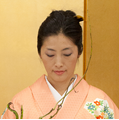Every year around May, ikebana enthusiasts from across Germany gather in the outskirts of Frankfurt for a 3-night, 4-day Ikebana Congress.
This year the Congress organizers wanted to feature some small ikebana schools, so they invited me, and I went and gave my first seminar as an instructor!
Out of 130 Congress attendees there were only three Japanese people, including an Ohara-ryu teacher from Japan. I was amazed to see the extraordinary enthusiasm of the ikebana aficionados from Germany and Switzerland. There were people who had been attending every year for 25 years or more, there were even sprightly grandmothers of 85 or 90 years, and many who had traveled 300 to 500 km to attend.
Another name for ikebana is “kado” (“the way of flowers”), which means walking the path of life together with flowers your whole life. I was happy to see so many German people fascinated by Japanese culture and practicing kado, some for many years.
Apparently, many feel they can concentrate without distraction when they are practicing ikebana, and that seeing the beautiful works they create soothes their souls. This brought home to me that in a way the Japanese sense of spiritual wellbeing is a secret to longevity.
The iemoto system (where the founder plays a central part in developing the school’s style) applies in the schools of ikebana, for example, Ikenobo (the oldest in Japan, famous for its arranging style of Rikka,“standing flowers”), Sogetsu (popular for freestyle arrangement), and Ohara-ryu (the creator of Moribana [flowers arranged in a wide-mouthed, shallow container]), so each school follows its distinct style of arrangement.
Another school is Koryu, a classical school of ikebana whose forte is “Oseika” (“seika” is written with the same characters as “ikebana”), adopting the principles of harmony of “heaven, earth, and man (leading element, following element, and harmonizing element)” in the mid-Edo period. The school I belong to is Koryu Toyokai, one of the schools derived from Koryu. We practice the unique art of “suibokuka temae” which involves “suibokuka”, arranging flowers like ink paintings on a square poetry card, to recital of “waka” (classical Japanese poetry), and finally cleansing the place where you have arranged the flowers with ritualized movements using a fukusa (silk cloth used in the tea ceremony).

My participation in the congress this time involved delivering a two- and a half-hour seminar three times. I taught the basics of suibokuka temae and “nageire (style of arrangement imitating nature) on the theme of fall leaves or eucalypt and peony”.


The seminar participants were all very experienced German kado practitioners who represented various other schools, which made for cultural exchange across school boundaries and a precious experience.
One of the other seminars, on the theme of “shukoka” (flower arrangement for special effect), was presented by Mrs. Zoo-Lan Lee-Rötter from the Ohara-ryu, a kado practitioner with some 50-years’ experience for whom I have great respect.
Her dinner-party table decoration with grapes and grape vine on a banana leaf was a work of originality representing the fullest expression of her ikebana skills and her imagination. The beauty of this work took my breath away. Here is a photo!!


Photos from other seminars (Kaden-ryu, Ohara-ryu)



I am still in the intermediate class, but with such valuable opportunities as this, I feel that I have at last managed to recommence my journey as a kado practitioner in Germany, which makes me very happy.
If you don’t practice your ikebana skills you lose them, but the more you hone them, the better they become, so I hope to learn all sorts of things from people with more experience in life than me, and to help a lot more people discover the joys of ikebana.






























































